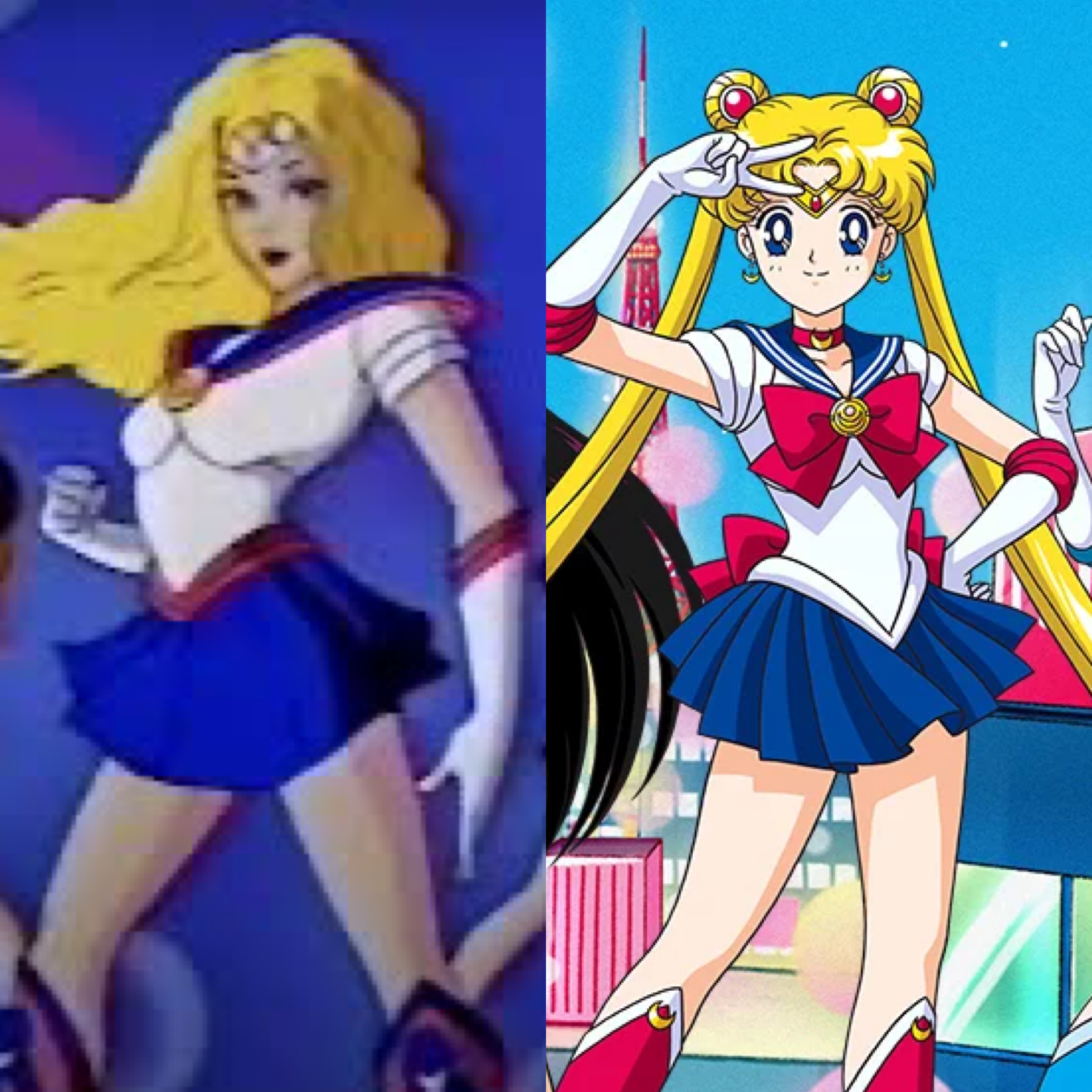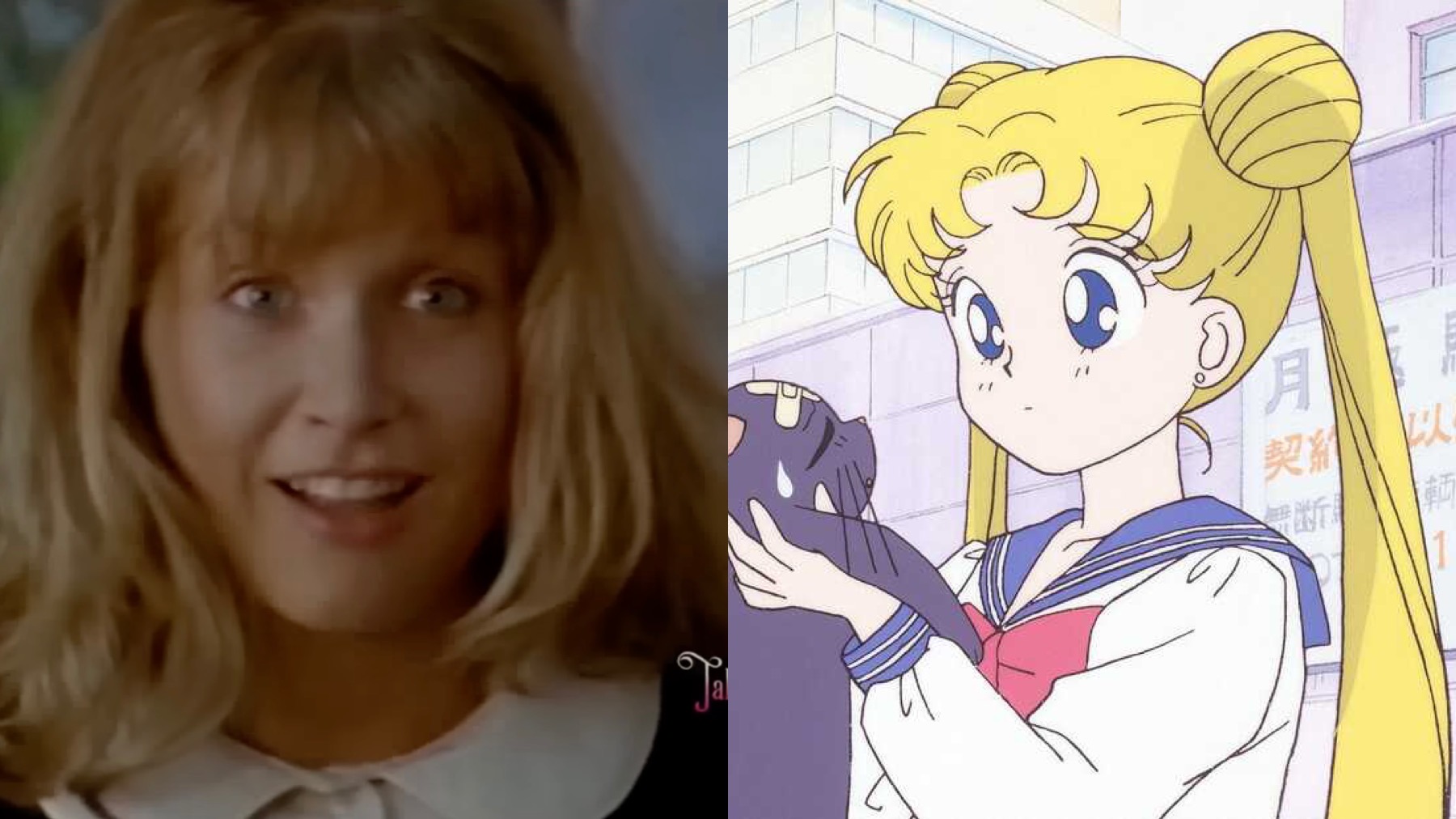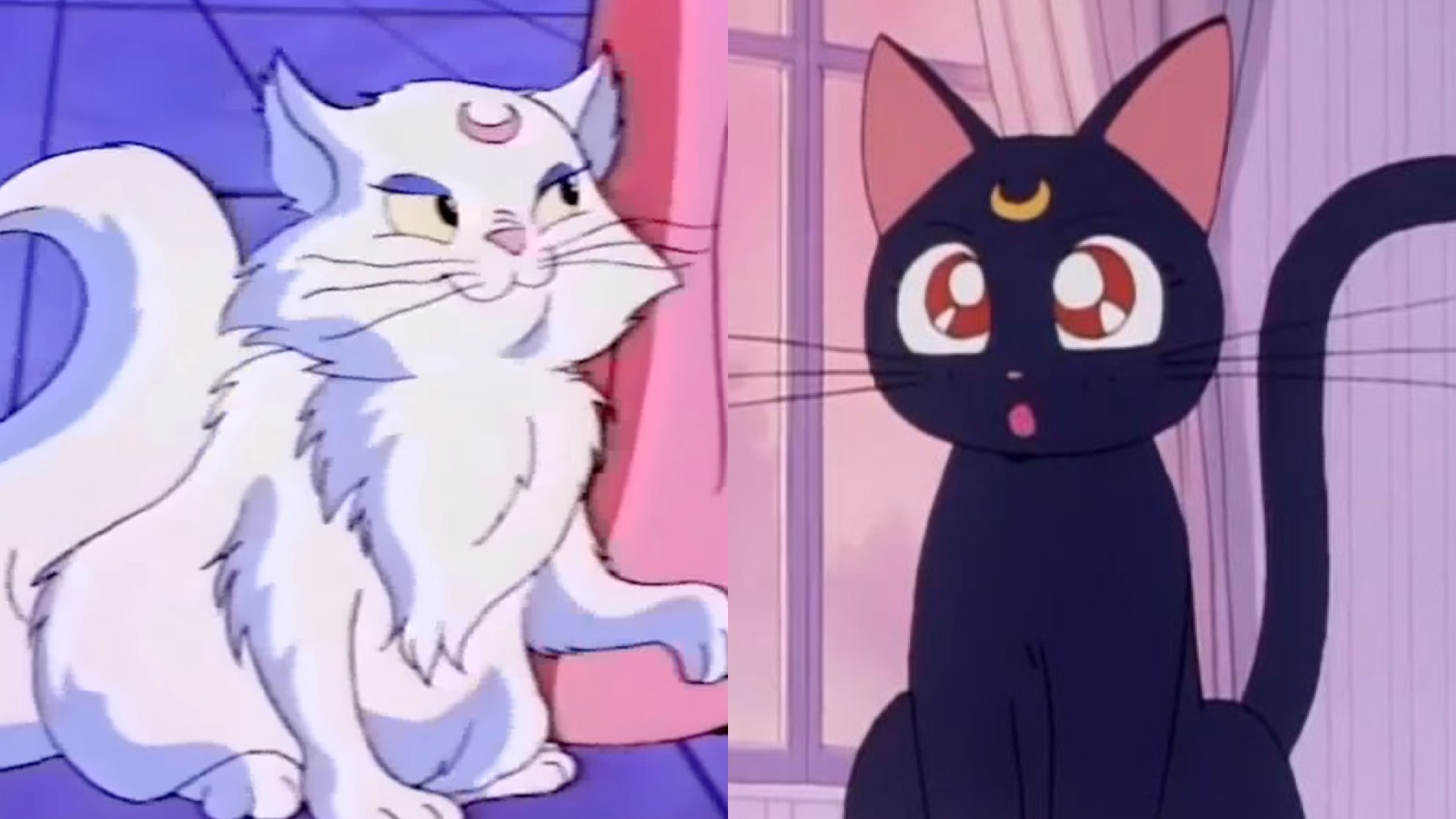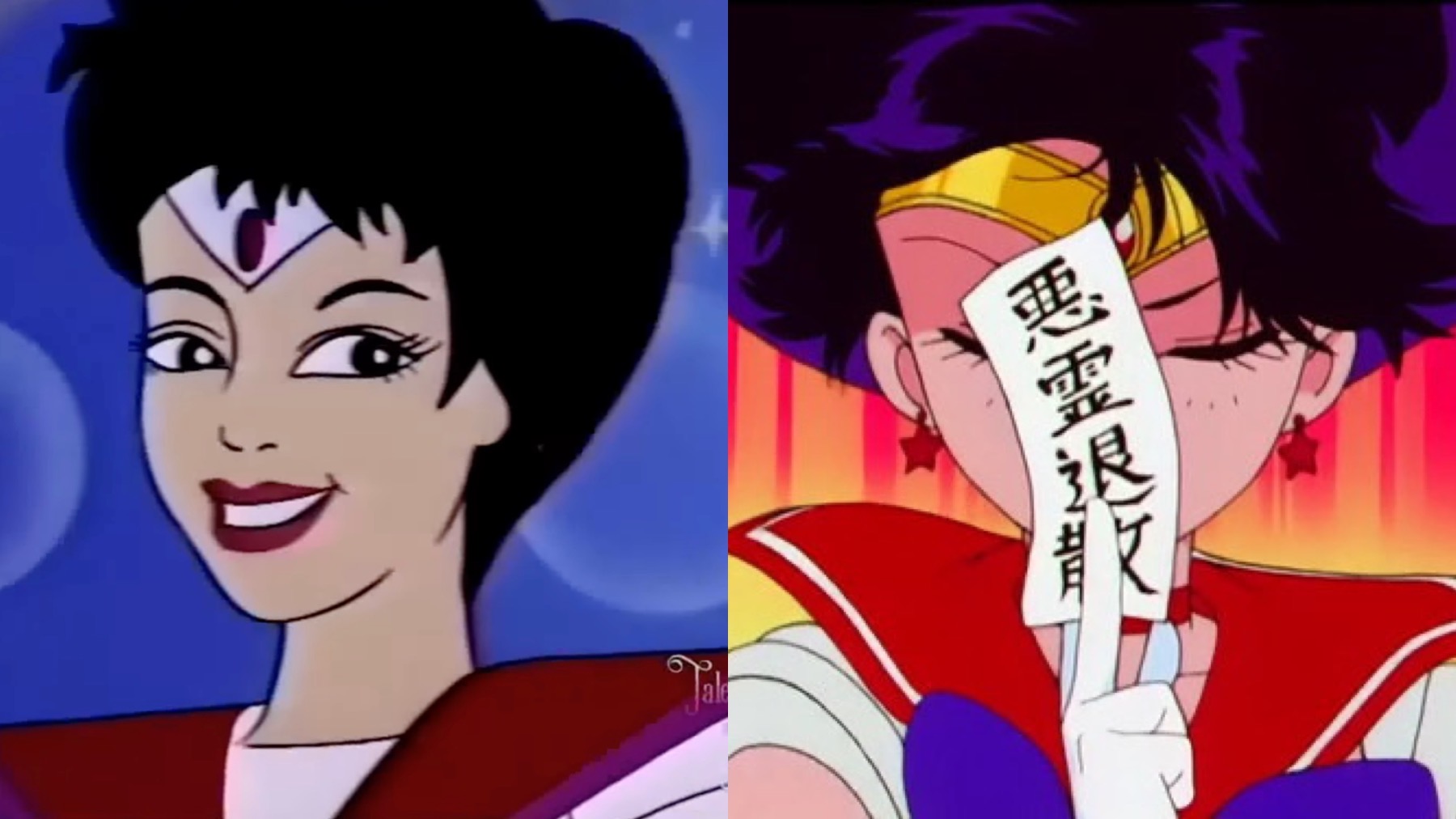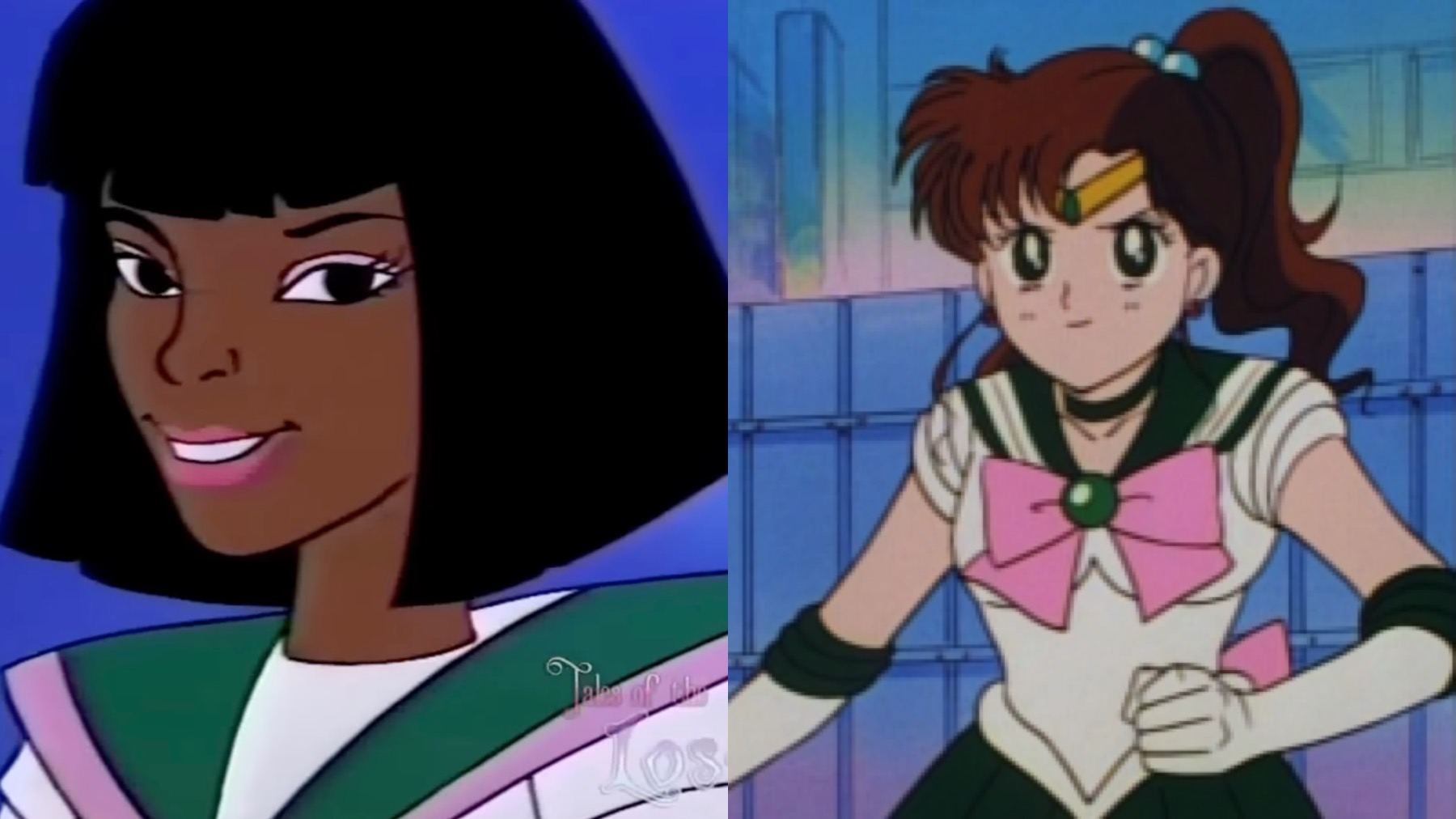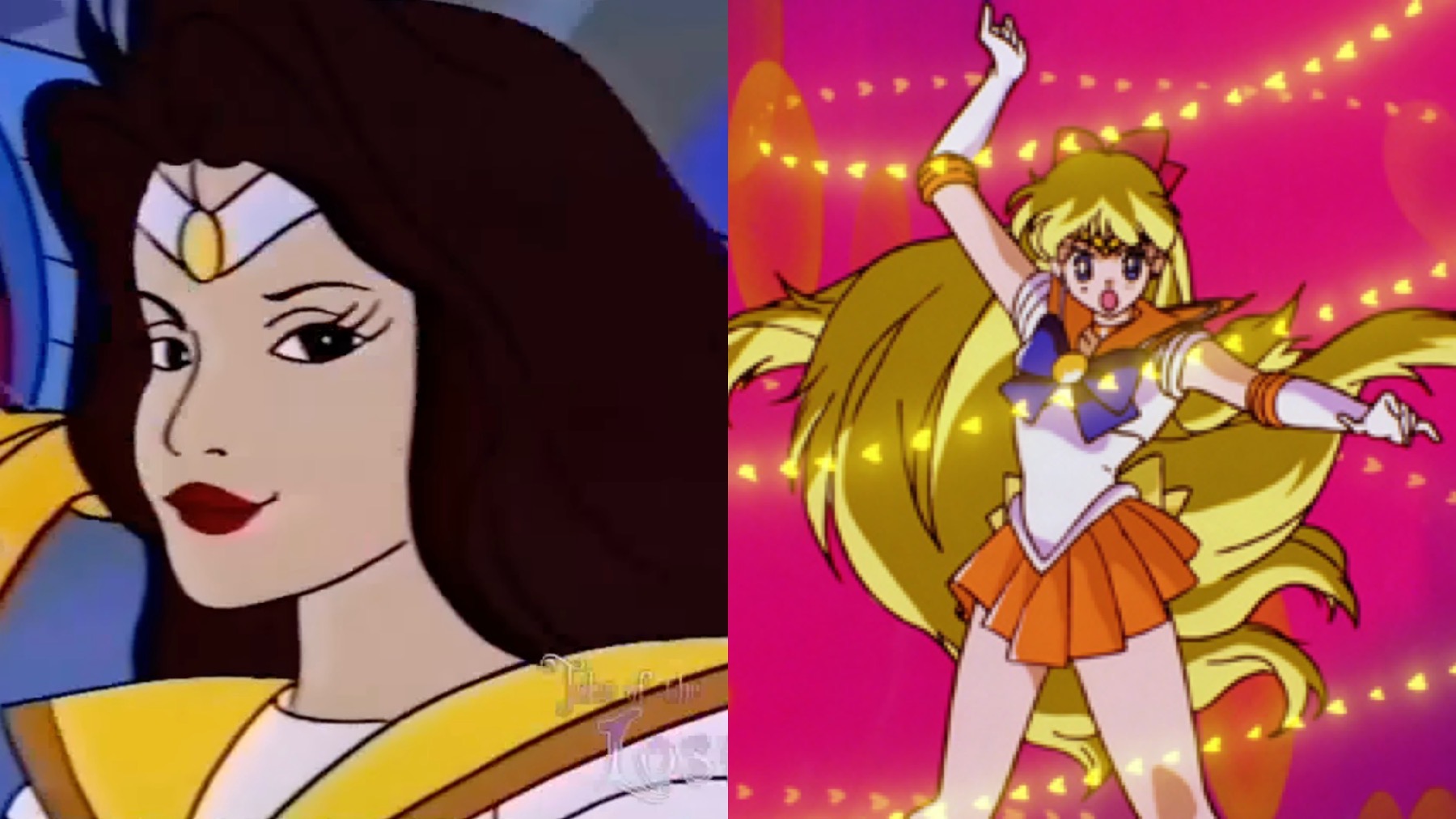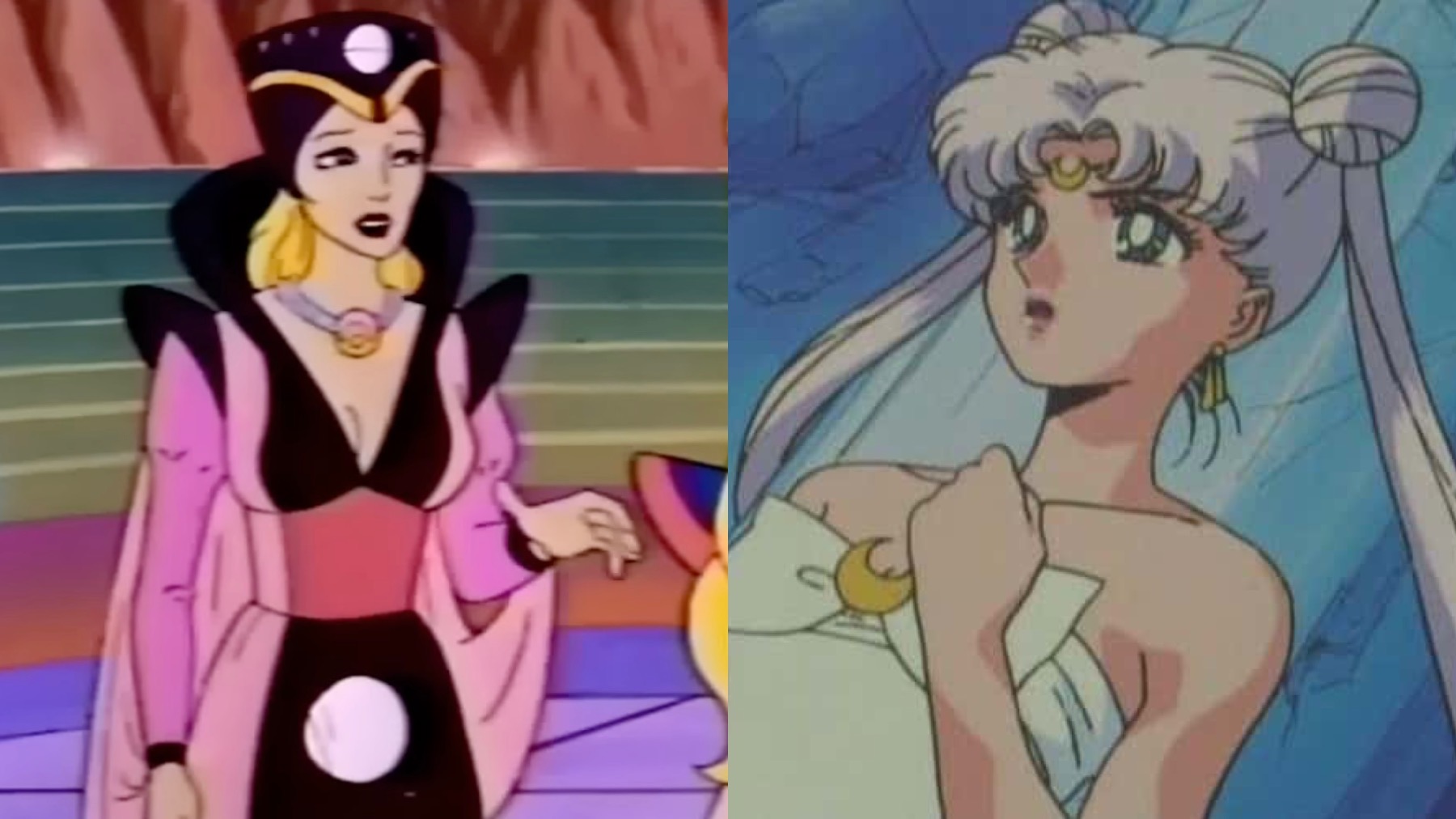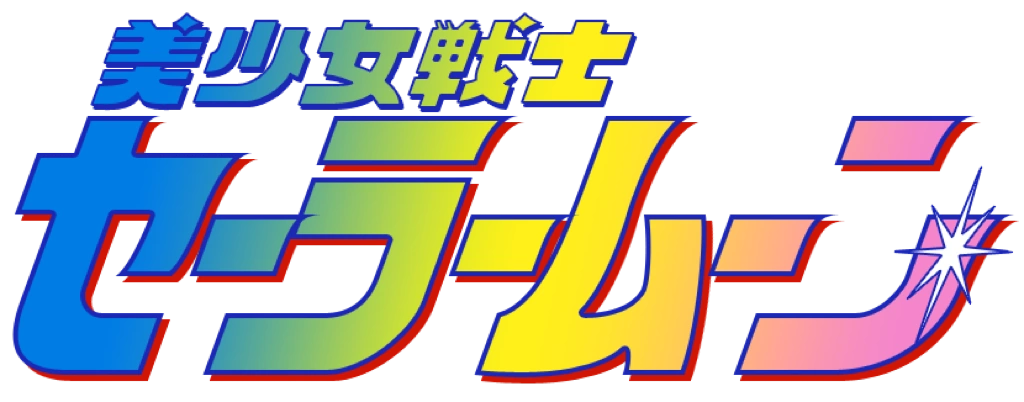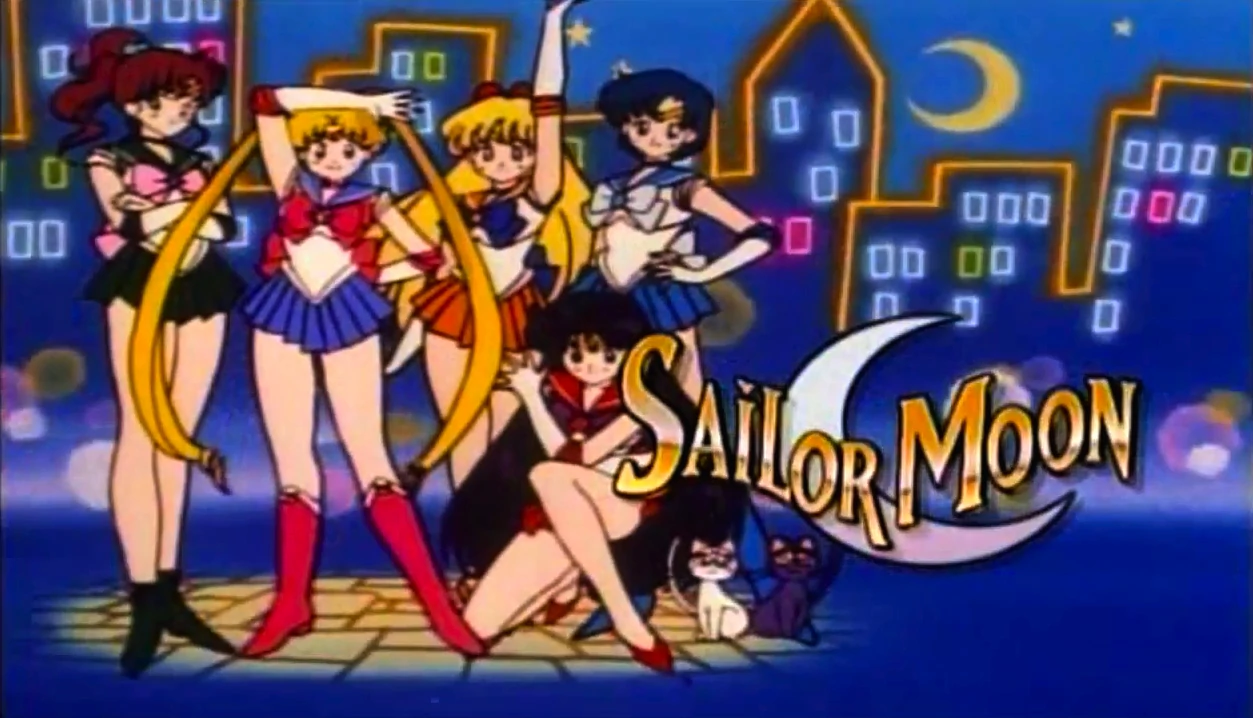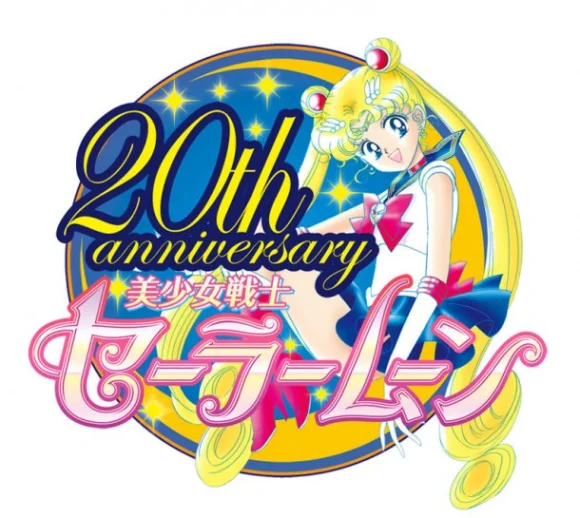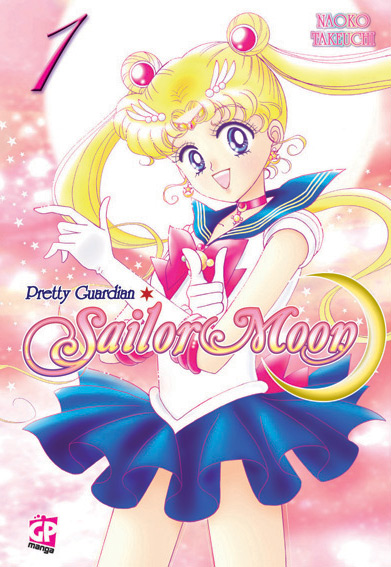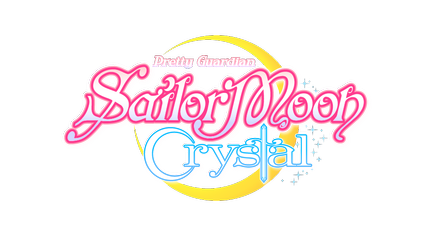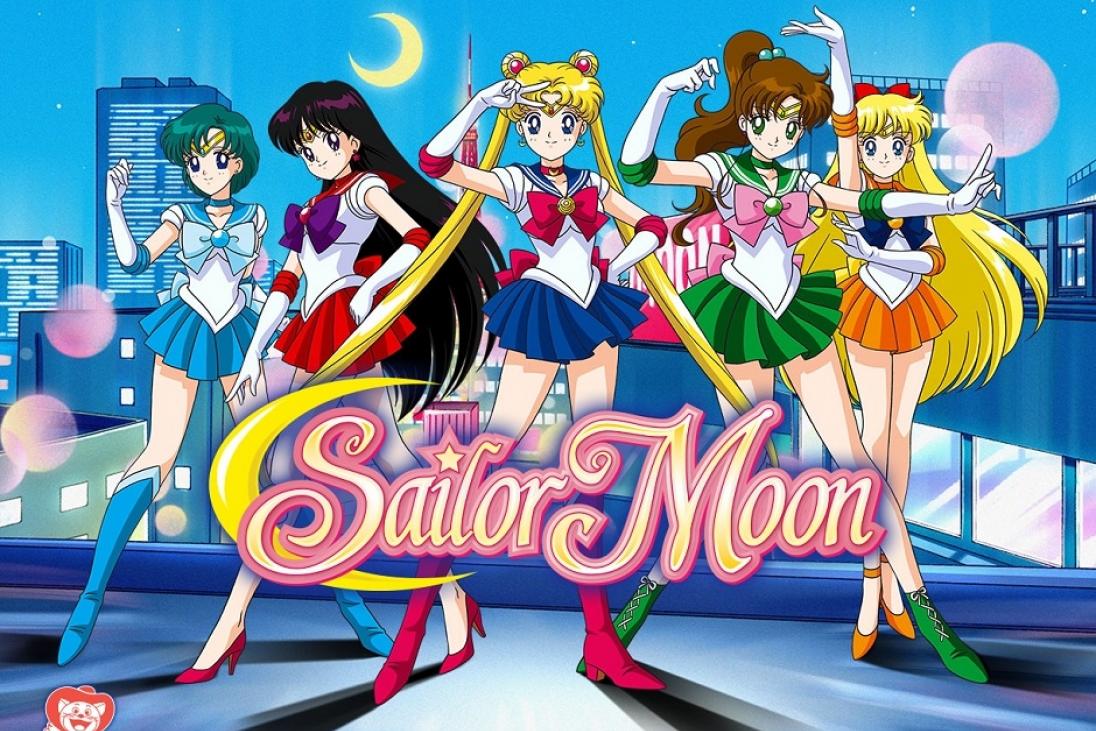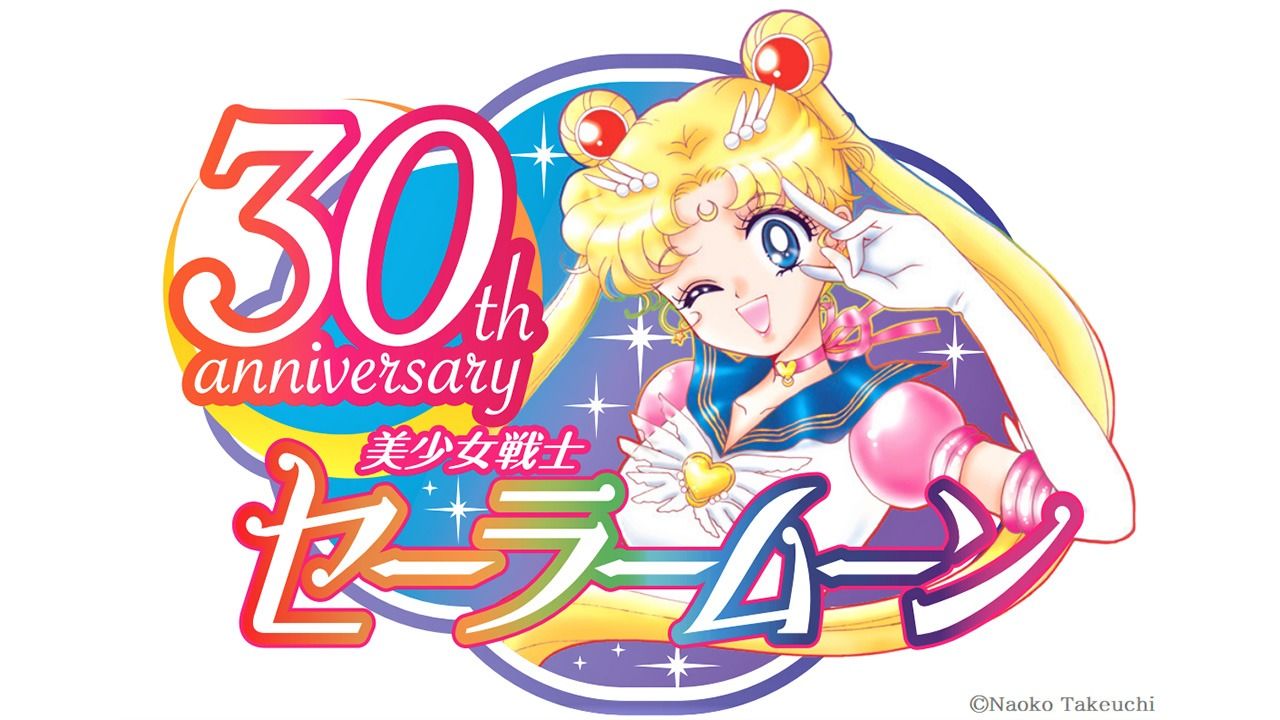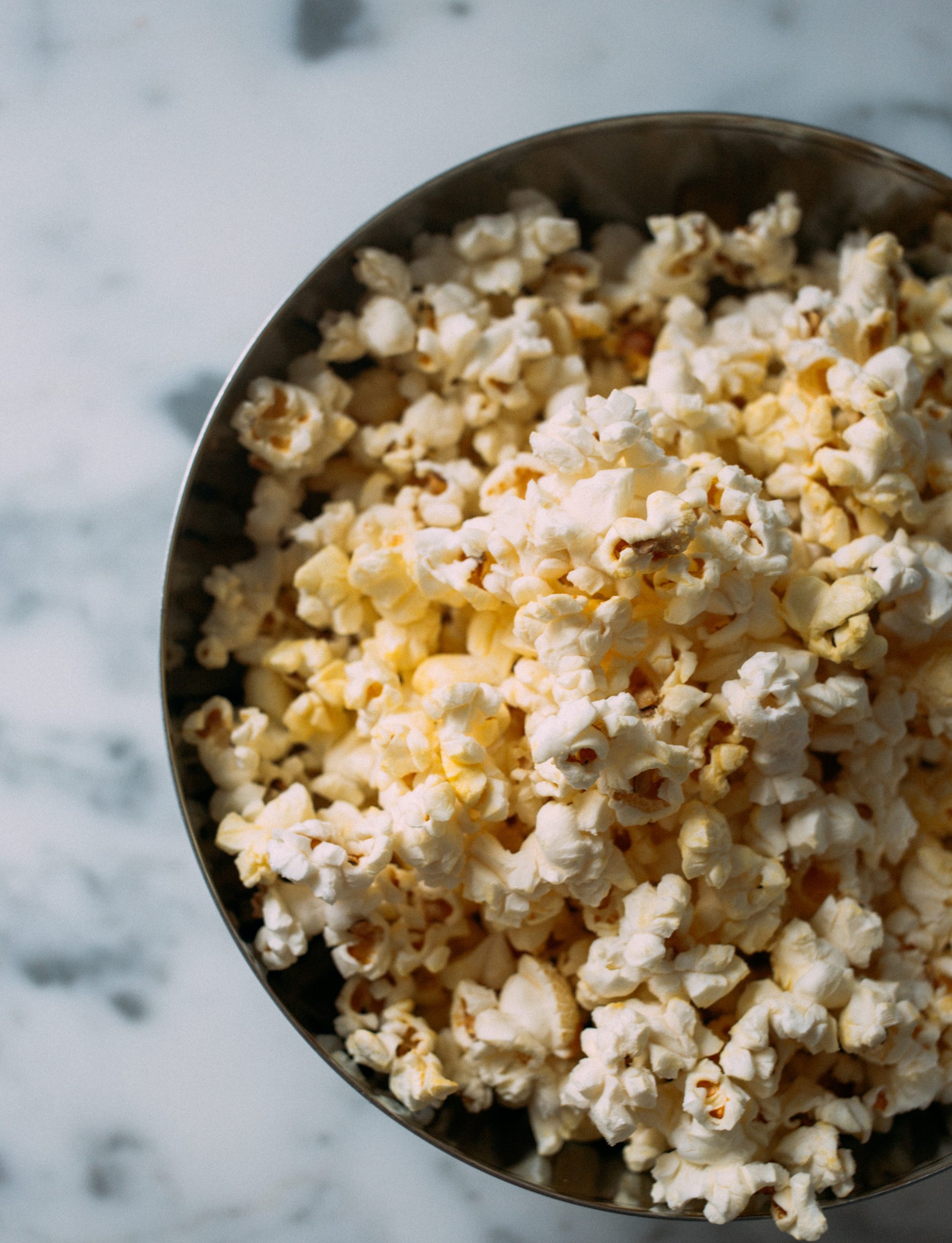You know what’s the best cure for paralyzing anxiety? Shenanigans! Because we live in the strangest timeline, something miraculous has been unearthed: the pilot video for the American adaptation of Sailor Moon. Oh, yes!
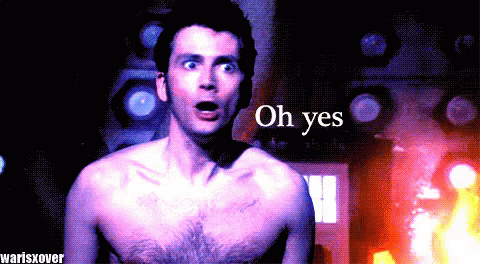
Before the original anime was dubbed, the powers that be (American television executives) first attempted to adapt the series for an American audience. Now look, I grew up watching Sailor Moon in the ‘90s, both weekday afternoons on Toonami and 6 am some mornings (I still have the original VHS). Point is: I’ve seen the “localization” of the original anime (we’ll call that SM1995), I’ve seen the redubbed version that’s more faithful to the original Japanese (SM2014), I’ve seen the Crystal remake, and I’ve read most of the manga (ADHD is tough, you guys). I feel pretty confident that I can explain how they are similar or different. Now, I’m gonna apply that knowledge to what has been dubbed, “Saban Moon”.
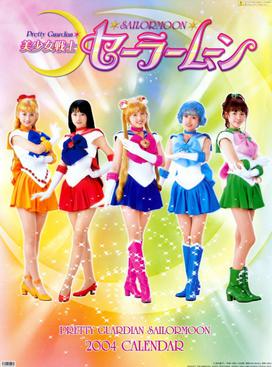
(Quick note: there also exists a Japanese live action series, Pretty Guardian Sailor Moon (2003), which the original manga creator, Naoko Takeuchi, actually worked on. It has not been officially released commercially in the US, but you can find clips online. As a live action Japanese series, it really cannot be compared to Saban Moon, which is the most Americanized, which is why I am leaving it out of this conversation. Let’s hope the discovery of Saban Moon leads to more interest in Pretty Guardian.)
First, let’s look at what each of these adaptations is. The original work is Sailor Moon, the manga, which ran from 1991-1997 with over 60 chapters and side stories. In the early 1990s, the manga was adapted into an anime. This was the first adaptation, which extends the story by adding in additional narrative elements, such as a monster-of-the-week format, forbidden romances, and an entire plot arc. I’ve neither read nor seen the last chapters, but my understanding is that this is where they differ. For our purposes, I’m going to only look at the first two plot arcs: “Dark Kingdom” and “Black Moon”. In the original anime, these two arcs represent seasons 1/Sailor Moon and 2/Sailor Moon: R (although season 2 begins with the anime-only arc). Sailor Moon: Crystal is an anime remake that was announced for the 20th anniversary of the franchise in 2012. It is a more faithful adaptation of the original manga, with each episode almost directly corresponding to a chapter (although later seasons have been made into movies). This new production was dubbed almost simultaneously for worldwide release (first with Hulu, now with Netflix). The renewed interest also led to the original anime and its 3 movies to be redubbed to be more faithful.
The english dub of the original anime began airing in 1995 (hence, SM1995). So how far off could the 90’s dub actually be? Well, I know I said I wasn’t going to talk about it, but in season 3/Sailor Moon S there is a lesbian couple, who are very deliberately labeled as “cousins” in the 90’s dub. That’s just the most blatant example, however. Episodes were also edited, and in some cases combined or cut, for content. Spoiler alert: everyone dies in the first arc, but DiC (a now defunct production company) removed that since it was supposed to be a cartoon aimed at ‘children’. Another really obvious change is the names, which were all westernized. Sailor Moon/Usagi became Serena, Tuxedo Mask/Mamoru became Darien, Sailor Jupiter/Makoto became Lita, and Sailor Venus/Minako became Mina. Sailor Mercury/Ami and Sailor Mars/Rei were simply westernized to Amy and Raye respectively. They also aged up the animal sidekick. Luna is a black short-haired cat with a crescent moon mark on her forehead and is supposed to be not much older than the girls, but in the American “localization” becomes a chaperone-esque, fairy godmother character, with a grandmotherly voice (this continues to throw me off even now). With that more or less summarized, we can now move onto the main event: Saban Moon vs Sailor Moon (1995).
Similarities and Differences
Contrary to the original manga and anime, both English versions, SM1995 and Saban Moon, begin by telling the story of the distant past, so the audience knows right away that Sailor Moon is also the princess. This was apparently meant to be a surprise, but SM1995 actually uses footage from later episodes as a sort-of prologue, thus spoiling the whole thing. Saban Moon similarly begins with a story of the distant past. Although this was not revealed in the early seasons of SM1995, Saban Moon explains that Sailors Moon, Mercury, Mars, Jupiter, and Venus are princesses of their respective planets. In both, The Queen of the Moon is Serenity, Sailor Moon’s mother, and Sailor Moon is in love with Darien, Prince of the Earth, who is represented by a rose and gives Moon a star necklace. In both versions, Queen Beryl, who represents some kind of dark force, comes and destroys the peace in her quest for power. For their own safety, Queen Serenity sends Moon, Mercury, Mars, Jupiter, and Venus to Earth. On Earth, the girls now must balance a normal life with fighting Queen Beryl.
The differences are obvious from the beginning, of course. Just the animation alone is a stark contrast, although they use some of the same backgrounds for attacks and transformation scenes. Most notably, Sailor Moon’s meatballs are nowhere to be seen in Saban Moon! Her iconic “meatball head” includes two buns on either side of her head with long pigtails coming out. Saban Moon just has normal shoulder-length hair– not even proper floor-length anime hair! The Moon Kingdom is also very spacey and futuristic– think original She-Ra– which is a stark contrast to the western (like the EU and the US, not the cowboys) fairy tale castle in SM1995. The uniforms the “Sailor Scouts” wear bear slight differences, but keep the same color scheme. Actually, what’s most notable is Saban Moon’s attempts at multiculturalism and inclusivity. In SM1995, the characters are all Japanese anime characters, so they all have white-ish skin, big eyes, and hair that comes in a variety of colors. In Saban Moon, Sailor Moon is a white blue-eyed blonde, while Sailor Sailor Mars is asian, Sailor Mercury is a white girl in a wheelchair, Sailor Venus is a white brunette, and Sailor Jupiter is black. Another key visual difference is that when the girls are living their “normal lives” it is all done in live action. The transformation sequence is computer generated (a foreshadowing of Crystal or just new tech to play with?) for Sailor Moon, while the others just get a flash of color and their element (ie fire for Mars) that turns them from live action girls into cartoon superheroes. In contrast, every other version provides full transformation and attack sequences for all the major characters at least once (this does include Pretty Guardian, which I mentioned above).
The Plot
In Saban Moon, Queen Beryl needs to defeat the warrior princesses in order to take the magic crystals belonging to their respective planets. After she conquered the outer planets of our solar system, the inner planets and Earth’s moon formed an alliance with the moon at its center. They plan to solidify the alliance through the marriage of Prince Darien of Earth and Sailor Moon– yes, Sailor Moon, not Usagi, Serena, or Serenity, she really isn’t given another name as a princess. Queen Beryl arrives to interrupt the festivities, now with blue skin and standing atop a horned spaceship. The princesses/Sailor Scouts rush to their “sky fliers” (which resemble windsurfing boards) to fight Beryl’s minions. Queen Serenity orders Darien and the princess warriors to escape to another dimension with a long-haired white cat with a crescent mark on its forehead. After Darien and his spaceship are seemingly blown up, the girls use their sky fliers to escape through a vortex to a parallel dimension’s Earth.
For reference, the original Sailor Moon story also depicts Queen Beryl coming to attack the moon. To save them, Queen Serenity, who also has “meatball” hair (“bun head” in the more accurate translations) uses her Crescent Moon Wand and Silver Crystal to transport Princess Serena/Serenity (American/Japanese versions), the prince, and the Sailor Scouts/Guardians to the future. They are reincarnated many centuries later as normal humans on Earth, specifically in Japan. In the past, the Princess is not Sailor Moon, but the other girls are her friends and protectors.
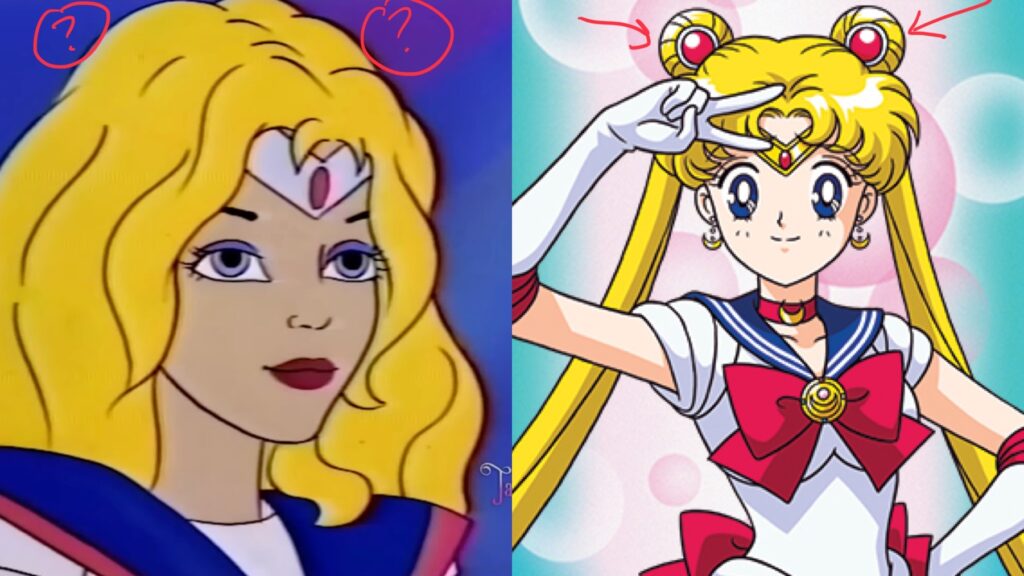
For reference, the original Sailor Moon story also depicts Queen Beryl coming to attack the moon. To save them, Queen Serenity, who also has “meatball” hair (“bun head” in the more accurate translations) uses her Crescent Moon Wand and Silver Crystal to transport Princess Serena/Serenity (American/Japanese versions), the prince, and the Sailor Scouts/Guardians to the future. They are reincarnated many centuries later as normal humans on Earth, specifically in Japan. In the past, the Princess is not Sailor Moon, but the other girls are her friends and protectors.
In Saban Moon, following the escape, we transition into live action scenes for the “normal girl” portion of the story. While a blond girl, presumably Sailor Moon, staring out the window, normal!Venus reveals that normal!Moon’s name is Victoria. The girls have a dance that night, so normal!Venus needs to borrow lipstick. Remembering the dance, Victoria gets excited and thus begins a dance break featuring the girls being ‘normal’ and getting ready for the dance while the theme song plays in the background. (Yes, it is very cringy.) Here we also get some hints at each girl’s personality. Normal!Mars is a sporty asian tomboy and normal!Mercury is implied to be a soft-spoken girly-girl in a wheelchair, while normal!Jupiter is a black nerdy mathlete and normal!Venus is a boy-crazed brunette. Luna, who speaks telepathically and cracks jokes, interrupts the fun because Queen Beryl is attacking Jupiter, so they need to go take care of that. In Sailor Moon the civilizations on other planets no longer exist when they begin fighting again.
One thing that does stay the same between Saban Moon and SM1995, is the condescending idea of what it means to be a teenage girl. In Saban Moon’s dance break, the girls talk about boys and dating and how they have nothing to wear in front of a closet stuffed with clothes. SM1995 adds a little segment at the end of each episode called “Sailor Moon Says” that addresses “girl issues” such as weight gain/loss, friendship, doing the right thing, etc. There is also plenty of vapid dialogue in the actual episodes.
Now to nitpick:
In all Sailor Moon media, transformations (and often attacks) typically occur in order of when they entered the series: Moon, Mercury, Mars, Jupiter, Venus. In Saban Moon, the order is Moon, Jupiter, Mercury, Mars, Venus. Saban Moon’s transformation item is also an item that Sailor Moon doesn’t gain until Season 2/the end of the first plot arc. When they attack in Saban Moon, there are no special attack names, although Sailor Moon does get some of the poses from the original anime (specifically, she has her “Moon Tiara” attack and Venus’s “Love-Me Chain” although it’s just a beam.
Another key difference in how the girls are depicted is that the Saban Moon characters know who they are, where they came from, and exactly why they need to fight. In all other Sailor Moon media, the girls do not remember their past lives until they all start to come together. The Sailor Moon girls have been living lives on earth since they were born, while the Saban Moon girls are literally aliens. As a result, the Saban Moon team is a little more responsible because the stakes are more real to them. Of course, in both Amerianizations, the girls are made more shallow, but, at least in the pilot video, no one is trying to dodge their responsibility.
The girls are also of different ages. In the original manga and Crystal, the girls begin as junior high students while Sailor Moon/Usagi/Serena’s love interest, Tuxedo Mask/Mamoru/Darien, is in high school. In the first anime adaptation, the girls are still middle school students, but Tuxedo Mask/Mamoru/Darien is in college. When I realized this as a teenager, and even now as an adult person, my response is “ick”, but cultural differences and it was the early 1990s and I think we all just sorta handwave that away. Age of consent is also very different in Japan than in the US and that’s all that I think needs to be said about that.
Saban Moon ages up the girls, however. At the very beginning of the manga, Sailor Moon/Usagi/Serena tells the audience that she is 14 years old. You can take that at face value, or, if you want to nitpick, recognize that in Japan a child is counted as one year old at birth. I do not believe this is something the American television executives ever took into account, but it’s an interesting and nitpicky thing to know. So, if you wanna be really technical, the girls would be 13 years old in the US. Saban Moon has the girls aged up to 16 years old (it says so in the lyrics) and presumably in high school (the actresses all look super young, so like actual high schoolers, but by our standards they’d be cast as middle schoolers).
I’ve already addressed how the characters are physically changed, but their personalities are also changed as well. In Sailor Moon, Mercury is the first ‘Sailor Scout’ Sailor Moon connects with. She has short blue-black hair and is considered a genius, but very shy. Before meeting Moon, she was an outcast because people thought she was cold. (Before I forget, Sailor Moon’s ultimate power in Sailor Moon is friendship.) Her powers are water-based but she also has some high tech accessories, which are less impressive in 2022 than they were in 1991. Saban Moon’s Mercury is a red-head wheelchair user. Other than the physical differences, her short appearance doesn’t seem to be such a departure from the original, other than not being the genius of the group. Her transformation image suggests her element is water (even if her attacks do not) and she uses high tech devices (mainly her chair) to both move around and attack.
In the original, Moon and Mercury next meet Mars. In the original, Mars has long black hair and spiritual powers. She works at her family’s shrine as a shrine maiden, or miko, so she has additional powers of foresight and intuition. Some of her attacks even utilize Japanese talismans. The manga and Crystal portray her as a graceful character, while the first anime gives her more of a temper, so she acts as almost a social rival to Moon. She was also an outcast– considered creepy because of her psychic powers– before Moon came into her life. Saban Moon’s Mars is very obviously a tomboy. She has short hair (like a pixie cut) and when she is preparing for the dance she is trying to choose between sports jerseys. This is a huge departure from the original, although her element remains fire.
Next comes Jupiter, who transfers to Moon and Mercury’s middle school. She stands out immediately because she is significantly taller and more buxom than her peers. With her brown hair in a ponytail, she would be considered the tomboy character of the anime. She is actually a martial arts expert, however, she also dreams of being a housewife one day; in addition to wearing rose earrings that stay during her transformation, Jupiter also enjoys and is quite good at cooking and sewing. Her element is thunder/lightning. Saban Moon’s Jupiter is a black girl with chin-length black hair and is depicted as the brainiac of the group. Although she maintains the same element, her appearance and personality, like Mars, are a much larger departure than the others.
Venus is a complicated character, who was also a bit of an outcast in her normal life. She began fighting as ‘Sailor V’ long before she met the others. She even has her own cat companion, a white tomcat named Artemis (and yes, this confused the hell out of me when I started learning about Greek and Roman gods in school), who is eventually Luna’s love interest. If you haven’t noticed by now, there is some correlation between the powers the girls have and their planet, which is also the name of a Roman god. More people are familiar with the Greek names: Mercury is Hermes, Mars is Ares, Jupiter is Zeus, and Venus is Aphrodite. Mars is often represented as a fiery character, while Zeus is known for his thunderbolts. Similarly, Venus has love-based attacks. However, because she was also Sailor V (and therefore created before all of the others– she had her own manga series and everything), she also has some moon-related powers. For example, her first primary attack is the ‘crescent beam’. Saban Moon amped up the Venus-Aphrodite connection. Saban Moon’s Venus is clearly boy crazy and depicted as the most upset about missing the dance. In the anime and manga, Venus is actually very similar to Moon. She has long blonde hair and big blue eyes and she’s a little disorganized in her normal life. She is also, however, the most responsible of the group and the original leader. In the 90s anime, none of the girls is particularly more boy crazy than the other, typically for comedic effect.
We get very little on Prince Darien in Saban Moon. Mainly, that he is in love with Sailor Moon and apparently dies escaping the attack from Beryl. Some really interesting choices are made here, however. During the engagement ceremony, Prince Darien gives Sailor Moon a star necklace and a white rose. In Sailor Moon, he also gives her a star locket, which is later important to the plot. Tuxedo Mask is also always represented by a rose. In Sailor Moon, Tuxedo Mask throws a red rose when Sailor Moon is in trouble. His costume consists of a tuxedo with a cape, cane, and top hat. Saban Moon ditches the top hat and switches to a white rose (which is actually used in the extra plot arc of the original anime). The white rose in Saban Moon seems to give Sailor Moon additional power. Although the original anime does not convey this as well as the manga or Crystal, Tuxedo Mask and the love between them becomes a major source of power for Sailor Moon as time goes on. Although the original anime has Princess Serena/Serenity (Sailor Moon/Usagi’s alter ego) defeating Queen Beryl alone/added by her friends’ spirits, Crystal and the manga show Tuxedo Mask by Sailor Moon’s side (while her friends provide her with additional strength in other ways).
Theme Music
The last thing I want to look at are the theme songs and logos for Saban Moon and SM1995. Notably, they share the same logo:
For comparison, here is the logo for the redub:
Now, the theme song. The original Sailor Moon anime uses a song called “Moonlight Densetsu” for seasons 1-4. For the Americanized anime, the song’s tune remains the same, but the lyrics are changed. Saban Moon uses a different theme song altogether. Both American versions give you an idea of what the show is about:
Note: I typed these out from memory/listening to the theme songs
Sailor Moon (1995)
Fighting evil by moonlight,
winning love by daylight.
Never running from a real fight,
She is the one named Sailor Moon!
She will never turn her back on a friend.
She is always there to defend.
She is the one on whom we can depend,
She’s the one named Sailor…..
SAILOR VENUS
SAILOR MERCURY
SAILOR MARS
SAILOR JUPITER
Her secret powers are so new to her,
She is the one named Sailor Moon.
[guitar solo]
Fighting evil by moonlight,
winning love by daylight.
With her Sailor Scouts to help fight,
[She is the one named Sailor Moon.] x2
She’s the one… SAILOR MOON [echos]
The opening for Sailor Moon (1995) includes images from the original Japanese opening theme along with clips from various episodes.
The lyrics explain that Sailor Moon works with her friends, Venus, Mercury, Mars, and Jupiter to fight evil, while balancing a daily life. She is super powerful even if she isn’t used to her powers yet and she prioritizes the safety of others.
Saban Moon
The opening for Saban Moon plays over images from the pilot video, which seems to include a slumber party and a hallway dance party.
The lyrics say essentially the same thing and yet… Perhaps it is nostalgia goggles, but the second one is so cringe. It really highlights that she is a crime fighting superhero but also a typical teenage girl.
Saban: Looks like an angel flying higher than a bird
SAILOR SAILOR MOON
She’s got a life and another here on Earth
SAILOR SAILOR MOON
Her talking cat Luna gives her advice
Princess fighters stand by her side.
[SAILOR
SAILOR MOON] x2
Sometimes she’s a fun-loving 16 year old girl
SAILOR SAILOR MOON
Other times she’s a superhero for the world
SAILOR SAILOR MOON
She can get dressed up and look so sweet
Then morph into a force that can’t be beat
[SAILOR
SAILOR MOON] x2
She’s ready to fight for all that she believes in
SAILOR SAILOR MOON
She’s gonna stop evil forces and save the galaxy
SAILOR SAILOR MOON
She and her four princess fighter friends
Gonna crush crime time and again
[SAILOR
SAILOR MOON] x2
For additional comparison, I’ll copy-paste translated Japanese lyrics of “Moonlight Densetsu”, the theme from the original anime, and “Moon Pride”, which is the theme for the first two seasons of Crystal (and, incidentally, my ringtone). I have found that Japanese lyrics are often more about describing a key emotion or theme. “Moonlight Densetsu” is one example. “Moon Pride”, however, directly references what they say to transform from normal girls into Sailor Guardians: “Make-up” as in “Moon Power Make-Up!” or “Mercury Power Make-Up!”, etc. Perhaps because this was also released as a response to the 20th anniversary of the franchise, there are more direct references/implications towards the plot and the story.
For these songs, I just looked up the lyrics on WikiMoon because these are translated into English from Japanese.
Moonlight Densetsu
I’m sorry I’m not honest,
I can say it while I’m dreaming,
My thoughts are on the verge of overloading,
I want to see you right now
Moonlight makes me want to cry,
At midnight I can’t call you,
But I’m so devoted, what should I do
My heart is a kaleidoscope
Ushered by the light of the moon
We meet again over and over
The sparkling lights of the constellations predict the whereabouts of love
Born on this same planet, a miracle romance.
Once again, on a weekend, we’re together,
A happy ending granted by the gods,
The present, past, and future,
I’m completely devoted to you
That time when we met, that dear
Look I’ll never forget
Among millions of stars I’ll find you,
Coincidences becoming chances, I like this way of life
A strange miracle crosses over,
We meet again over and over
The sparkling lights of the constellations predict the whereabouts of love
Born on this same planet, a miracle romance.
Do you believe in it? A miracle romance.
Moon Pride
Moon Pride
I want to become your strength
Tears running down cheeks; eyes burning crimson
As fiercely as lightning; someone is yelling love out loud
No matter how dark it is I won’t be alone, right?
Moonlight shines upon us
Ah, there is a saying taught to girls for not giving up
It is “don’t leave your fate to the prince, fight with your own strong will”
Shiny Make-up, we’ll shine together under the starry sky
We’re not frail girls who need to be protected
Rocked by the waves of sorrow; scorched by the flames of wrath
As dazzingly as lightning; I swear this love is eternal
Even if we’re apart right now I’m not alone, right?
The moonlight connects us
Ah, all girls have an invincible weapon
It is the strength to gaze closely at one’s weakness and accept it all
Shiny Make-up, we’ll glitter together under the starry sky
Our bond that transcends time and space gives me strength
My feelings of longing are so painful that bring tears to my eyes
My fledgling heart is lonely and I want to meet you
No matter how many times we are reborn in this wide universe,
I’ll fall in love with you
Shiny Make-up, we’ll soar beyond the starry sky
Sin makes the world go round, but I’ll believe in the future
–Therefore
Shiny Make-up, we’ll end this under the starry sky
A new legend will begin here and now
La La Pretty Guardian SAILOR MOON
Conclusion
The unearthing of Saban Moon has really taken me for a walk down memory lane. Honestly, I’d lately been watching Digimon Adventure 01 and Adventure 02 for the first time in 20 years, so I’d already been thinking about what it felt like to watch these programs when they first aired. Sailor Moon has always had special meaning for me, however. It really influenced me quite a bit growing up. Seeing what could have been, especially as someone who has now studied television and fandom, I am so grateful they just dubbed the damn thing. I love being able to compare so many different versions of the same property, but ohmygod, the American production is a MESS. There are just some really awful 90s tropes happening that got toned down when they dubbed the anime. That being said, if someone wants to revive Saban Moon, I would very gladly watch, but only if it takes place in the 90s. I want the Stranger Things treatment for Sailor Moon (because that’s really what it would be).
So, overall, I am grateful to Saban Moon because it gives us a glimpse into the past, what might have been, and also helped get me writing again. Thank you, Saban. You gave us Power Rangers, Teenage Mutant Ninja Turtles, and now we have this.
Extra:
Now, just because I love it, here is a link to the official music video for Moon Pride: Moon Pride Music Video. If you turn on Closed Captioning (CC), it will give you English subtitles. Also, here’s a collection of Toonami Promos so bask in the nostalgia or just experience a major part of my childhood. Below, I also have a collection of images comparing Saban Moon and Sailor Moon.
